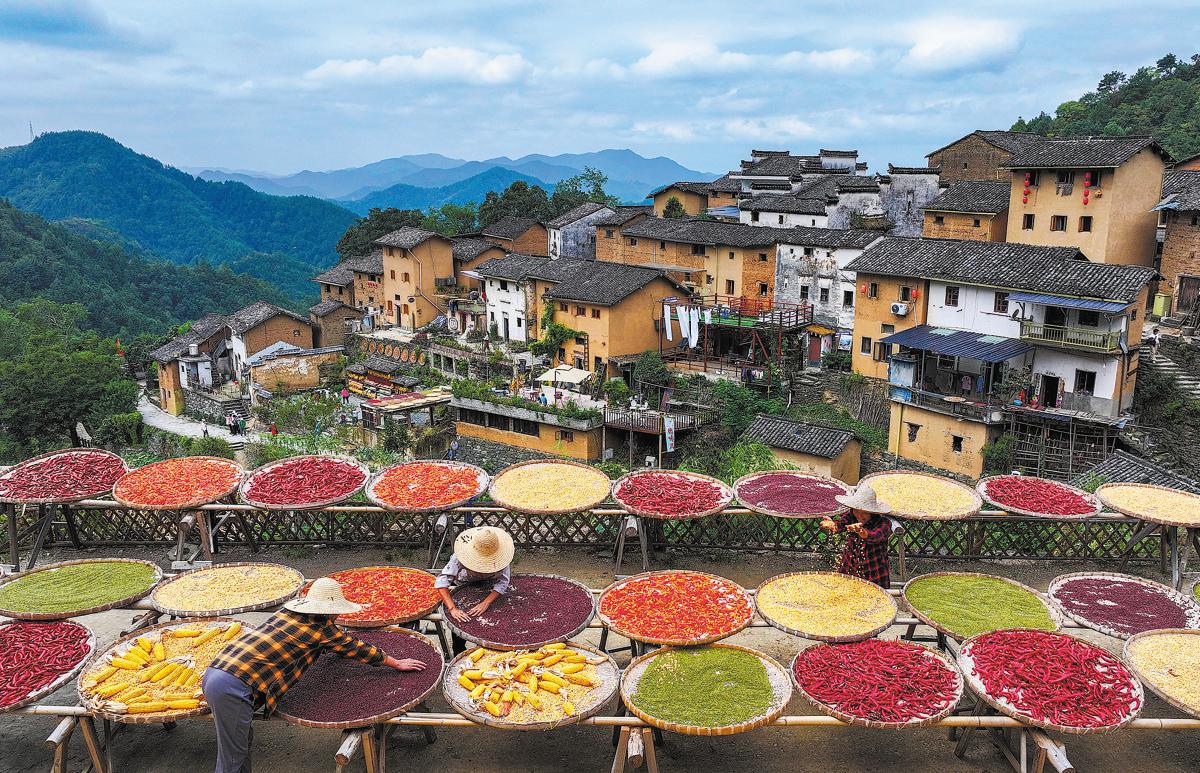
Farmers dry their produce in Shexian county, Anhui province, on Sunday, the seventh Chinese Farmers' Harvest Festival. The festival, initiated in 2018, falls on the Autumn Equinox, one of the 24 solar terms on the Chinese lunar calendar. SHI YALEI / FOR CHINA DAILY
After decades of urbanization that have brought remarkable progress, propelling China to become the world's second-largest economy, the government is ramping up efforts to achieve more balanced, coordinated development to narrow the gap between urban and rural areas amid the nation's modernization drive.
On the eve of the seventh Chinese Farmers' Harvest Festival, which fell on Sunday, Xi Jinping, general secretary of the Communist Party of China Central Committee, reiterated the nation's commitment to building a more prosperous countryside.
He also extended festive greetings and sincere regards on behalf of the CPC Central Committee to farmers and comrades working on agricultural and rural fronts across the country.
Xi, who is also Chinese president and chairman of the Central Military Commission, called on Party committees and governments at various levels to make every effort to enhance the economic benefits of agriculture, increase farmers' incomes and inject greater vitality into the countryside, in order to bring tangible benefits to farmers.
Furthermore, he said it is imperative to persistently consolidate the foundation of agriculture and promote comprehensive rural vitalization to advance Chinese modernization, and he urged farmers and people from other sectors to take actions to transform the blueprint for rural vitalization into reality.
Meanwhile, despite the recent increase in rural income resulting from extensive poverty alleviation efforts, rural residents continue to lag economically.
According to the National Bureau of Statistics, the per capita disposable income of rural residents was 21,691 yuan ($3,076) last year, approximately half the national average.
Wu Haitao, a researcher of poverty issues at Zhongnan University of Economics and Law, said, "The urban-rural disparity is also reflected in the access to various social welfare benefits."
Urban areas outperform rural regions in almost every aspect, including infrastructure, public services and social security provisions, such as elderly care and the pension fund system.
In August, authorities set a goal to increase the proportion of urban residents to 70 percent of China's population within the next five years, and to reform the two-track urban-rural household registration system as part of the country's "people-centered" urbanization initiative.
Without local household registration documents, known as hukou, tens of millions of rural migrants often face limited access to public services in the cities where they work.
The commitment to advance new urbanization was emphasized at the third plenary session of the 20th Central Committee of the CPC, held in Beijing from July 15 to 18.
Traditionally pivotal in the decision-making of the CPC leadership, the third plenary sessions are considered to be "steering wheels" in China's economic reforms and serve as a crucial platform for adjusting top-level decisions and building consensus.
The communique from the recent third plenary session described the integration of urban and rural areas as essential to the country's modernization goals.
Jiang Quanbao, a professor of demography at Xi'an Jiaotong University, said the integration was proposed to narrow the gap in the living standards between urban and rural areas while preserving the unique characteristics of rural regions during the merging process.
"This aims to enable residents in both areas to gradually lead a different but equal life," he said.
The communique emphasized the importance of aligning "new industrialization, new urbanization, and comprehensive rural vitalization", and it called for the enhancement of urban-rural planning, construction and governance integration.
It also stressed the necessity of equal resource exchanges and two-way flows between urban and rural areas to reduce disparities, foster common prosperity and promote development.
Jiang noted that barriers remain to establishing a unified national market, such as the enduring spatial isolation between urban and rural areas, which obstructs the smooth two-way flow of resources.
"At the macro level, the State must eliminate institutional barriers and focus on breaking down the urban-rural binary structure," he said.
For a long time, cities have been drawing resources, particularly labor, away from rural areas. Wu, the researcher, said that instead of this one-way flow, capital, technology and management expertise from urban regions should also be directed toward rural areas.
"The purpose is to achieve optimal resource allocation and promote the overall coordinated development of the urban and rural economy and society," Wu said.
While migrant workers primarily work in cities, their needs for social support such as elderly care and child-rearing are predominantly rural concerns.
Jin Xiaoyi, a professor at Xi'an Jiaotong University's School of Public Policy and Administration, said the old approach had equated urbanization solely with urban construction.
"It neglected the transformation of rural migrants in aspects such as employment, social security and public services as they move from the countryside to the city," she said.
Jin highlighted the mismatch of two sets of figures.
Between 2006 and 2019, the annual growth of land in urban areas was about 1.7 times the growth of permanent residents, which the professor said was proof that old-fashioned urbanization was more "land-centered".
While 63.89 percent of China's population were permanent urban residents in 2020, only 45.4 percent held urban hukou. This indicates that hundreds of millions of rural migrants have yet to receive equal treatment compared with urban residents.
The third plenary session held in July called for enhancing institutional mechanisms to advance new urbanization.
Jiang, the professor of demography, said: "The new urbanization model focuses on people and quality improvement. The key is to effectively address issues such as the education of children of rural migrant workers, housing and social security."